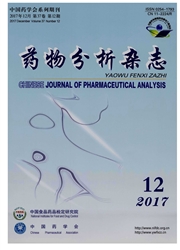

 中文摘要:
中文摘要:
目的:冬虫夏草与古尼虫草在外观上相似度高,最易混淆,本研究将从基因水平对两者进行准确鉴别。方法:通过聚合酶链式反应扩增,得到样品的内转录间隔区(ITS)序列,同时从Gen Bank下载2种虫草的ITS序列;利用Codon Code Aligner和MEGA软件对ITS序列进行分析,找到2种虫草差异的酶切位点;通过聚合酶链式反应-限制性片段长度多态性(PCRRFLP)实验进行验证。结果:在ITS序列上,冬虫夏草存在1个SacⅡ酶切位点,而古尼虫草不具有该位点。PCR-RFLP的实验结果表明,冬虫夏草ITS序列的PCR产物可被限制性内切酶SacⅡ切割为2个片段,大小分别约为488 bp和128 bp,古尼虫草不能被SacⅡ切割,所以酶切前后其PCR产物在琼脂糖凝胶图上的位置没有变化。从子实体取样和从虫体取样得到一致的结果。结论:PCR-RFLP法可以将冬虫夏草与古尼虫草明确区分,取样部位不同对本方法的结果没有影响。
 英文摘要:
英文摘要:
Objective: To identify Cordyceps sinensis from Cordyceps gunnii at the DNA level. Methods: The internal transcribed spacer( ITS) of Cordyceps sinensis and Cordyceps gunnii were obtained both from sample sequencing and Gen Bank. The sequences of ITS region was analyzed with the software Codon Code Aligner and MEGA,and the different restriction sites was found between the ITS regions of the two kinds of Cordyceps. Finally,validate this finding was validated with polymerase chain reaction- restriction fragment length polymorphism( PCR-RFLP) experiment. Results: There is a single restriction site of SacⅡ enzyme within the ITS region of Cordyceps sinensis,while this site is absent on the ITS region of Cordyceps gunnii. Results of PCR-RFLP experiment showed that after being incubated with SacⅡ enzyme,the PCR product from Cordyceps sinensis was cut into two fragments with the molecular weight 488 bp and 128 bp respectively,while there is no cleaved fragment in the group of Cordyceps gunnii after enzyme incubation,which indicates that the PCR products was not cut by SacⅡ. The same results were visualized no matter where the samples were taken,i. e. from the fruit body or from the worm body. Conclusion: The established PCR- RFLP method is accurate and simple in identifying Cordyceps sinensis from Cordyceps gunnii. Different ways of sampling didn't affect the final results.
 同期刊论文项目
同期刊论文项目
 同项目期刊论文
同项目期刊论文
 期刊信息
期刊信息
